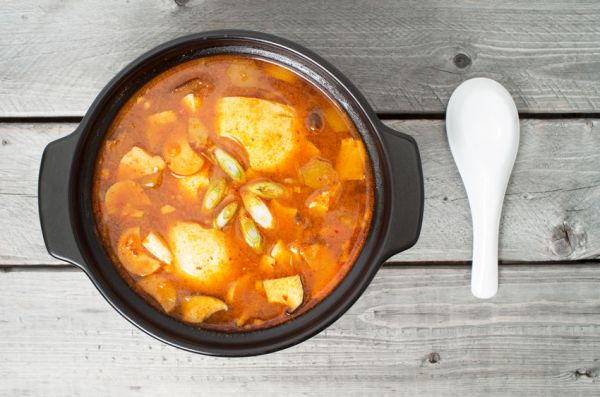Kimchi-jjigae – Reboot

And a requested reboot from December of 2007.
Winter is here, cold, rain turning to sleet and snow, the need for warming hearty fare is pressing. So soup, but what soup? I say french onion, my wife says Asian, I loose.
From wikipedia:
Kimchi-jjigae or kimchi stew is a stew-like Korean dish, made with kimchi and other ingredients, such as scallions, onions, diced tofu, pork, and seafood. It is one of the most common jjigae in Korea.
Kimchi jjigae is often cooked in Korean homes using older, more fermented and “ripe” kimchi, creating a much stronger taste and containing higher amounts of “good” bacteria (also found in yogurt). (Living bacteria in fresh, uncooked kimchi will not survive the cooking process.) The stew is said to be more flavorful if prepared with older kimchi, while fresh kimchi may not bring out a full and rich flavor. Kimchi is the most important ingredient in kimchi jjigae. Other ingredients depend on personal preferences.
Sliced kimchi is put into a pot with beef, pork, or seafood; tofu; sliced spring onions; and garlic. They are boiled with water or myeolchi (anchovy) stock. The stew is seasoned with doenjang (bean paste) or gochujang (red pepper paste).
Like many other Korean dishes, kimchi jjigae is usually eaten communally from the center of the table if more than two people are served. It is accompanied by banchan (side dishes) and rice. It is usually cooked and served boiling hot in a stone pot.
I will update this to a more healthy and vegetarian / vegan friendly dish. And if you do not have bean paste, any miso will do.
I’ll start with a basic Spicy “Asian Trinity” and build my flavors from there.
Side note on the “Asian Trinity” / “Chinese Mirepoix”
We all know that ginger, scallion, garlic, and chilies are common aromatic vegetables in Chinese cuisine, but there’s far too much variation across China to narrow it down to one simple answer—the specific aromatics used, and how they’re combined, change from region to region.
In Guangdong, the southern and most populated province in China, for instance, the flavors of the food tend to be more delicate and mild, with aromatics like ginger and scallion.
Head northwest of Guangdong to Sichuan, and you’ll encounter a totally different flavor profile. Known for its generous use of dried chilies and garlic, Sichuan cuisine emphasizes spicy, mouth-numbingingly bold flavors.
Travel northeast to Beijing and you’ll discover something different yet again. The same can be said about the food in Hunan, Shandong, Fujian, etc. This is why a single type of mirepoix just doesn’t exist in China. Still, it is possible to generalize by dividing Chinese cuisine into two distinct and broad flavor groups: the spicy (chili peppers and garlic), and the aromatic (ginger, scallion, and garlic).

Kimchi-jjigae
Ingredients
Method
- In a large sauce pan over medium heat, add vegetable oil When oil spiders
- Add Onion, Celery, Bell Pepper, Jalapeno, Mushrooms, kimchi Saute until onions are translucent and mushrooms are taking on color Add white and light green scallion pieces and saute 1-3 minutes, looking to soften Add Garlic and saute 1 minute additional
- Add in all but the sesame oil, whisk to combine and bring to a simmer for 15-20 minutes
- Taste and balance flavor Divide into bowls, garnish with thinly sliced reserved scallion tops, drizzle with sesame oil Serve with rice on the side.
Nutrition
Notes
Tried this recipe?
Let us know how it was!
Filed
under: Asian, Cultural-Misappropriation, Korean, Pub Food, ReBoot, Soup
Be the first to write a comment.
Your feedback
You must be logged in to post a comment.
You must be logged in to post a comment.